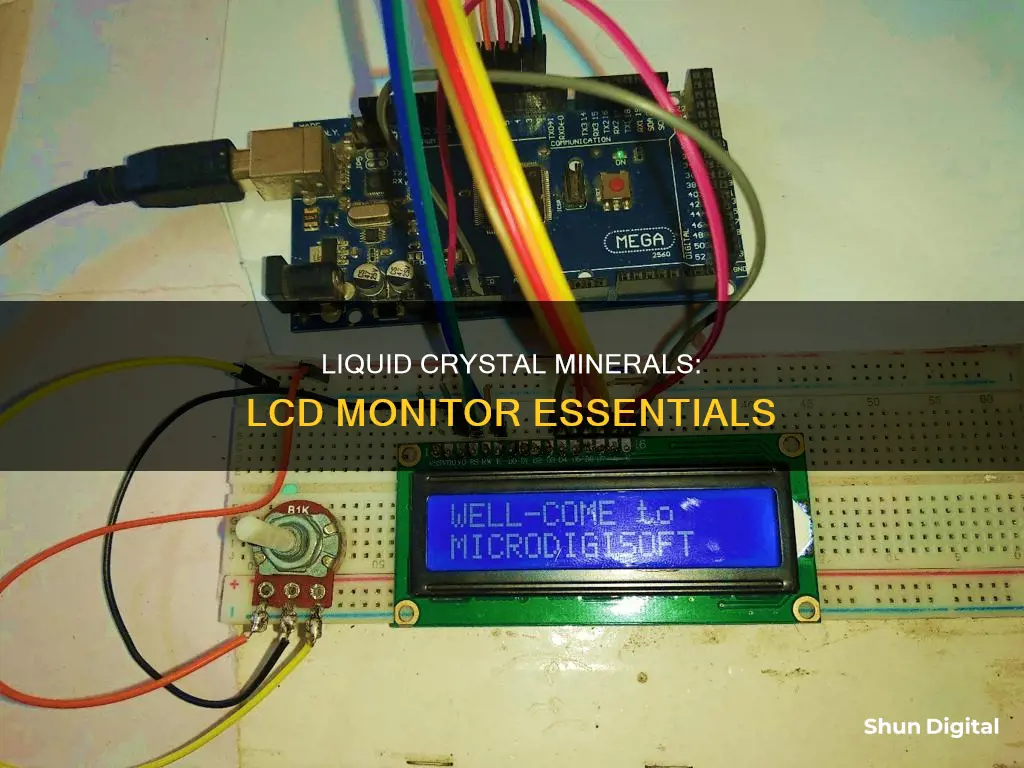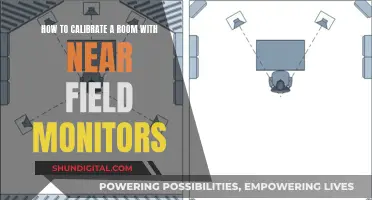
Liquid Crystal Displays (LCDs) are used in a variety of devices, from smartphones and televisions to computer monitors and instrument panels. LCDs are made up of liquid crystals that are activated by electric current, allowing them to switch between a transparent and cloudy phase. The liquid crystal itself is a state of matter with a crystal-like molecular structure that can block or allow light to pass through. This unique property makes it ideal for displays, as it enables the production of crisp images while keeping the monitor thin and power-efficient. While LCDs have been widely adopted, newer display technologies such as OLEDs are now offering even thinner designs and improved performance.
| Characteristics | Values |
|---|---|
| Definition | Liquid Crystal Display (LCD) |
| Description | A type of flat panel display which uses liquid crystals in its primary form of operation |
| Use Cases | Smartphones, televisions, computer monitors, and instrument panels |
| Replaced Technology | Cathode Ray Tube (CRT) |
| Power Consumption | Consume much less power than LED and gas-display displays |
| Resolution | The quality of a display commonly refers to the number of pixels; for example, a 4K display is made up of 3840 x 2160 or 4096x2160 pixels |
| Pixel Composition | A pixel is made up of three subpixels; a red, blue, and green—commonly called RGB |
| Backlight | LCDs are lit by a backlight, and pixels are switched on and off electronically while using liquid crystals to rotate polarized light |
| Types | Twisted Nematic (TN), In Panel Switching displays (IPS Panels), Vertical Alignment Panels (VA Panels), and Advanced Fringe Field Switching (AFFS) |
| Replacement Technology | Organic Light-Emitting Diodes (OLEDs) |
What You'll Learn
- Liquid crystals are a state of matter that can block or allow light to pass through
- LCDs use liquid crystals to rotate polarised light
- LCDs are made with either a passive or active matrix display grid
- Twisted Nematic (TN) displays are inexpensive with high response times but low contrast ratios, viewing angles and colour contrasts
- In-Panel Switching (IPS) displays have better contrast ratios, viewing angles and colour contrast than TN displays

Liquid crystals are a state of matter that can block or allow light to pass through
LCDs are made up of pixels, each of which consists of a layer of liquid crystal molecules aligned between two transparent electrodes. These electrodes are often made of indium tin oxide (ITO) and are paired with two polarizing filters. The axes of transmission of these filters are usually perpendicular to each other. Without the liquid crystal layer, light passing through the first filter would be blocked by the second. However, by applying an electric field, the orientation of the liquid crystal molecules can be altered, allowing varying amounts of light to pass through and create different levels of grey. This is achieved by controlling the voltage applied across the liquid crystal layer in each pixel.
The liquid crystal molecules naturally line up in the same direction as their neighbours, even as they flow past each other. This alignment has a strong influence on light travelling through the material. In a twisted nematic (TN) device, the liquid crystal molecules arrange themselves in a helical structure, inducing a rotation of the polarization of incident light, resulting in a grey appearance. When a large enough voltage is applied, the molecules in the centre of the layer become almost completely untwisted, and the polarization of the incident light is not rotated. This light is then blocked by the second filter, and the pixel appears black.
LCDs can be either normally on (positive) or off (negative), depending on the polarizer arrangement. They are used in a wide range of applications, including televisions, computer monitors, instrument panels, aircraft cockpit displays, and signage. LCD screens have largely replaced cathode-ray tube (CRT) displays due to their compact size, low power consumption, and lack of screen burn-in issues.
Finding the Right Monitor Size for You
You may want to see also

LCDs use liquid crystals to rotate polarised light
LCDs, or Liquid Crystal Displays, are a type of flat-panel display that uses liquid crystals and polarizers to display information. They are used in a wide range of applications, including televisions, computer monitors, and smartphones. LCDs have largely replaced older display technologies, such as cathode-ray tube (CRT) displays, due to their thinner form factor and lower power consumption.
The liquid crystals used in LCDs can have different chemical formulas, and the specific formulas may be patented. The liquid crystals are typically rod-like molecules that respond to the application of voltage by changing their orientation. This change in orientation affects the polarization of light passing through the liquid crystal, allowing for the control of light transmission.
LCDs with different types of liquid crystals can have varying performance characteristics. For example, Twisted Nematic (TN) LCDs are inexpensive and have high response times, but they have lower contrast ratios and viewing angles compared to other types. On the other hand, In-Plane Switching (IPS) LCDs offer improved contrast ratios, viewing angles, and color reproduction compared to TN LCDs.
In summary, LCDs use liquid crystals to rotate polarised light by arranging the liquid crystals with a twist between crossed polarizers. By applying an electric field, the twist can be removed, blocking the light and creating a dark area. This principle allows LCDs to control the transmission of light and create images on the display.
Bigger Monitors, Better Aim? Sensitivity and Screen Size Explored
You may want to see also

LCDs are made with either a passive or active matrix display grid
LCDs, or liquid-crystal displays, are available in two varieties: passive matrix and active matrix. The passive matrix LCD uses a grid of vertical and horizontal conductors made of Indium Tin Oxide (ITO) to create an image. Each pixel is controlled by the intersection of two conductors. By creating a potential voltage difference at the intersection, the LC fluid responds by creating an "on" state, or a pixel.
The active matrix LCD, also known as a thin-film transistor (TFT) display, uses a transistor located at each pixel intersection. This allows for the control of individual pixels and the ability to switch them quickly. The active matrix can produce higher resolutions and is used in full-color LCD TVs, monitors, cell phones, etc. The passive matrix, on the other hand, is used in calculators and digital wristwatches, where the display contains a limited number of segments and does not require full color.
The passive matrix is less costly than the active matrix and has a lower response time. However, the active matrix offers improved image quality with higher contrast, lower response time, and improved viewing angles. The passive matrix also suffers from color distortion and other problems when viewed from oblique angles.
The active-matrix LCD features a back panel made of silicon, which allows for the creation of a transistor for every pixel. This enables the active matrix to produce better images with higher contrast, lower response time, and improved viewing angles.
Calibrating LCD Monitors for Photography: A Step-by-Step Guide
You may want to see also

Twisted Nematic (TN) displays are inexpensive with high response times but low contrast ratios, viewing angles and colour contrasts
Twisted Nematic (TN) displays are a type of Liquid Crystal Display (LCD) that is known for its high performance and affordability. TN displays consist of a liquid crystal layer sandwiched between two polarizing filters, with the liquid crystal molecules twisted at a 90-degree angle. When an electric field is applied, these molecules untwist to varying degrees, controlling the amount of light that reaches the second filter. This mechanism allows TN displays to have incredibly fast response times and high refresh rates, making them an excellent choice for fast-paced gaming. Additionally, the technology used in TN panels is relatively simple and inexpensive to produce.
However, TN displays also have some limitations. They offer lower contrast ratios, viewing angles, and colour contrasts compared to other display technologies such as In-Plane Switching (IPS) and Vertical Alignment (VA) panels. The colours on a TN display may appear distorted or inverted when viewed from an angle, and the image quality can degrade significantly when viewed from extreme angles. This makes TN panels less ideal for professionals who require precise colour accuracy, such as graphic designers and photographers. While TN panels are suitable for casual gaming and general use, they may not be the best option for more demanding applications that require high-end performance.
TN panels are commonly used in gaming monitors and laptops due to their fast response times and affordable price point. They are also energy-efficient, as they consume less power compared to other panel types. TN displays are a popular choice for businesses that require adequate performance for general computing tasks while staying within a budget.
In conclusion, Twisted Nematic (TN) displays offer a balance between performance and cost. They provide high response times and refresh rates, superior brightness, and energy efficiency at a low price point. However, their limitations in colour accuracy, contrast ratios, and viewing angles make them less suitable for certain applications that demand higher-end performance.
Replacing LCD Monitor: Canon 5D III DIY Guide
You may want to see also

In-Panel Switching (IPS) displays have better contrast ratios, viewing angles and colour contrast than TN displays
In-Plane Switching (IPS) displays are a type of LCD technology that offers superior visual quality and performance compared to Twisted Nematic (TN) displays, particularly in terms of contrast ratios, viewing angles, and colour contrast.
IPS panels are renowned for their exceptional colour accuracy and wide viewing angles. They can display up to 16.7 million colours, delivering a consistent and accurate colour display regardless of the viewing angle. This makes them the preferred choice for professionals requiring accurate colour representation, such as graphic designers and photographers. In contrast, TN panels fall short in colour accuracy and viewing angles. TN panels can display only 262,144 colours, resulting in colour banding and distorted colours when viewed from different angles.
When it comes to contrast ratios, IPS panels once again excel. They provide accurate and consistent colours with a higher bit depth, offering 95% or more of DCI-P3, which is deemed perfect for digital cinema. TN panels, on the other hand, have poor contrast ratios typically ranging from 600:1 to 1200:1, making them unsuitable for photo or video editing.
Additionally, IPS panels offer wider viewing angles of up to 178 degrees, ensuring that colours and images remain consistent even when viewed from different angles. TN panels, on the other hand, have limited viewing angles, as low as 170 degrees horizontally and 160 degrees vertically. This means that colours can become distorted or washed out when the screen is viewed from extreme angles or from the side.
While TN panels have an advantage in response times and are favoured by gamers, IPS panels deliver a more well-rounded performance with their superior colour accuracy, viewing angles, and contrast ratios. This makes IPS displays the preferred choice for professionals in graphic design, photography, and other fields requiring accurate colour representation and comfortable viewing experiences.
Adjusting Text Size: Upgrading Monitors, Maintaining Comfortable Viewing
You may want to see also
Frequently asked questions
Liquid crystals are substances that exist in an intermediate state between a conventional liquid and a solid state. They are crystalline solids at low temperatures and clear isotropic liquids at high temperatures. LEDs, on the other hand, are light-emitting diodes that emit light directly.
Liquid crystals in an LCD monitor are controlled electronically and can be switched on and off to let light pass through or block it. This allows the display to show different colours and create images.
Liquid crystals allow LCD monitors to be much thinner than cathode ray tube (CRT) technology. They also consume less power because they work on the principle of blocking light rather than emitting it.
Common types of liquid crystals used in LCD monitors include twisted nematic (TN), in-plane switching (IPS), and vertical alignment (VA) liquid crystals.







